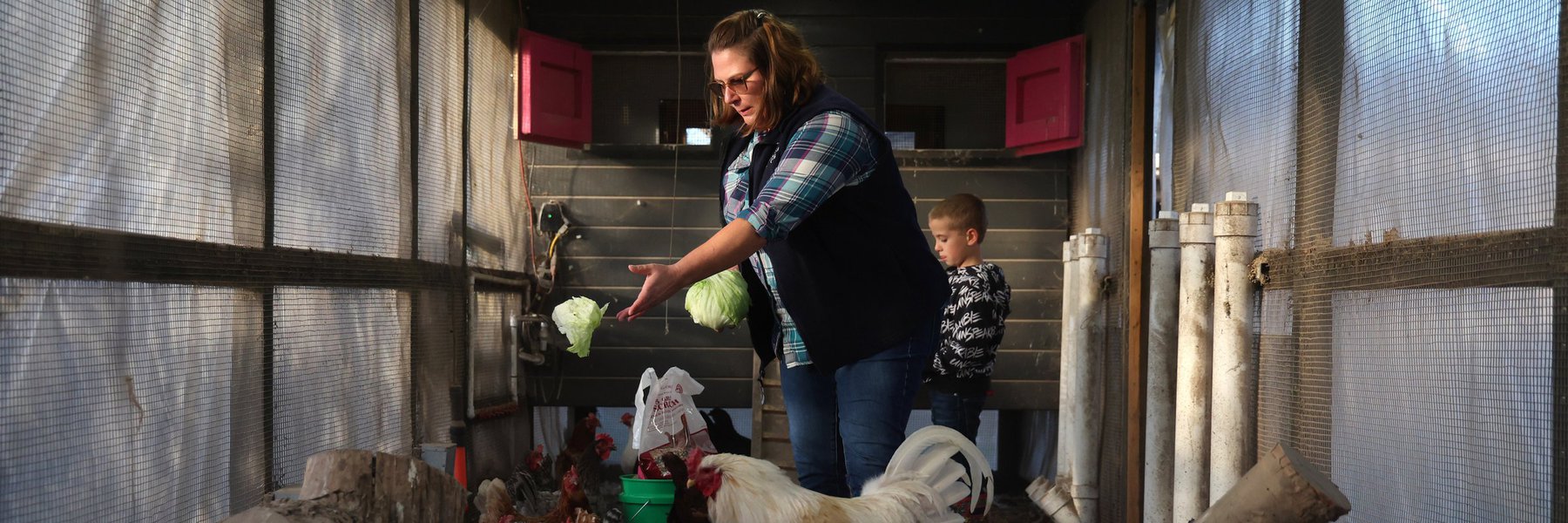A new father drove home from the hospital in downtown Modesto, scared — not by having a newborn baby, but by smoke-filled, “apocalyptic-looking skies.” Tom Helme couldn’t see past the next stoplight on the flat, straight road ahead. On that fall day in 2017, it was dark, he said, “like if a nuclear bomb went off, or something blocked the sun.” The San Joaquin Valley was already years into what regulators now say is a downward slide in air quality, choked by smoke from frequent wildfires.
In a recent report, the U.S. Government Accountability Office, the investigative arm of Congress, concluded that the Environmental Protection Agency’s response to wildfire smoke is “ad hoc,” poorly resourced and muddled by a lack of coordination with other agencies.
“You could ask anybody working on wildfire smoke and the answer is no, we’re not doing enough,” said Meredith Bauer, assistant director for the air and radiation division in EPA Region 9, which includes California. “Not yet. Not yet.”
Over the last three decades, the number of acres burned by wildfire has grown, spewing smoke across California and the country. The new GAO report highlights how a loophole in the Clean Air Act permits the EPA to erase pollution — not from the sky, but from the record.
The tool for erasing some of the worst air-pollution days is called the “exceptional events” rule — a legal pathway that allows local regulators to make a case that air pollution from “natural” wildfires shouldn’t count against their federal air quality goals.
Local regulators who seek to designate wildfires as exceptional events say doing so sets off a complex, burdensome process that is nonetheless essential to avoid slipping further away from meeting air quality standards — even if removing wildfire smoke from the record doesn’t actually clean up the air. According to the GAO, federal regulators have granted such requests more often over the last decade.
In Modesto, Helme first heard about exceptional events more than a year before his son’s birth, as a member of an environmental justice advisory group that meets with regulators. Officials at the San Joaquin Valley Air Pollution Control District had explained to the group that federal law permitted communities to avoid tighter regulation when pollution is “outside the control of the region.”
Helme says that at that meeting, he wondered out loud whether smoke from fires was going to become the norm. “Do you picture a time when it’s not going to be considered exceptional because it happens every single year?” he asked. “And what are our options with that?”
Erasing dangerous smoke from the data
Wildfire smoke is one of the fastest-growing sources of air pollution in the United States. Particulate pollution from fires drives health risks that are significant to pregnant people, children, outdoor workers, residents of leaky buildings and anyone with heart or lung ailments. Ozone produced by wildfires can cause irritation and inflammation of the lungs; even short-term exposure above certain levels raises the risk of premature death.
Yet, the 1970 Clean Air Act gives regulators little ability to take actions that could limit wildfire smoke. That’s because the landmark law focused on soot spewing from smokestacks and tailpipes. Policymakers viewed human-made pollution as the primary threat to public health, said University of Colorado at Boulder geographer Katie Clifford. “Ultimately the thinking about pollution was not about natural risks,” she said.
In contrast, the EPA, which enforces the Clean Air Act, has treated some wildfires, dust storms and volcanic eruptions as naturally occurring outliers.
“If pollution is created by people and it’s controllable, that’s what we want to manage,” said the EPA’s Meredith Bauer. “It’s everything that’s outside of that that we would call an exceptional event.”
The exceptional events rule, added to the Clean Air Act in 2005, has enabled regulators to ignore pollution data from some events when deciding whether a particular region must do more to improve its air quality. The closer that regions come to meeting federal air quality standards, the fewer restrictions local businesses and other polluters face. Forgiving wildfire pollution helps them meet those standards — and it has been happening more frequently over the last decade, according to the new GAO analysis, which named California, Colorado, Rhode Island and Texas as places that have sought to have wildfire pollution data excused.
Michael Wara, a Stanford Law School professor who directs the Climate and Energy Policy Program at the Stanford Woods Institute for the Environment, says the GAO’s findings are concerning.
“The whole point of the Clean Air Act is to protect people,” he said. “If a part of the law that was seldom used becomes frequently used, then the entire purposes of the act are being undermined.”
The GAO report makes it clear that the exceptional events rule is one of the few tools the EPA has to respond to the problem.
“There’s very little legal or regulatory language defining EPA’s role in smoke management other than our exceptional events program,” said Anna Mebust, an atmospheric scientist at the Environmental Protection Agency who works on exceptional events.
Wildfire smoke is “not something that the law was written to handle,” added Wara.
Hundreds of hours, hundreds of thousands of dollars
The GAO’s investigation also found that proving an exceptional event is burdensome. The EPA told the watchdog that “providing guidance for and reviewing the analyses demand a significant resource investment” for its regional offices. Local regulators described the process as overly cumbersome and convoluted.
“It is literally hundreds of hours of work” to prove that smoke pollution is an exceptional event, said Mark Loutzenhiser, who manages monitoring, programs and rules for the Sacramento Metropolitan Air Quality Management District.
Exceptional event demonstrations can run to hundreds of pages, just to write off smoke pollution for a day or two. Successful arguments help local communities avoid having to enforce stricter pollution controls.
“You have to show where the wildfire is. Was the wind actually blowing it there? Do you have satellite proof?” Loutzenhiser said. The EPA “look[s] at all of the pollutants. They look at all the weather conditions and they check to see, what do we think the pollution should have been, versus what did we actually measure? And you have to do this for every day of these exceptional events.”
Julie Hunter, interim air pollution control officer for the Northern Sierra Air Quality Management District, says preparing for a future exceptional event designation also means extra work tracking public health advisories and media reports about fire severity — even while it’s still burning.
All that effort during and after wildfires is costly. The GAO says some local and state regulators hire consultants to help, including government scientists at the National Oceanic and Atmospheric Administration. In public documents, states estimate it can cost from $50,000 to $150,000 to prepare a filing.
As the EPA considers tightening the national standard for fine particulates, and as conditions for wildfires are worsening with climate change, regulators say they may see more requests to excuse that pollution.
“We do need some help here. If the EPA will be constantly asking us for these large, resource-intensive packages … can we not streamline that, with EPA assisting us, saying, yes, we know that there was this giant wildfire?” Hunter said. “That’s our plea to EPA: Please help us streamline this process.”
Health risks grow, resources don’t
Even as smoke pollutes our air, the GAO reports that the EPA “does not have a coordinated agency-wide program or dedicated staff and resources for the agency’s work related to helping communities prepare for and respond to wildfire smoke.”
According to the report, work on wildfire smoke by the EPA is “done in addition to employees’ regular job duties.” Working on wildfire pollution is “like our Cinderella project — you know, after you’ve cleaned everything, you can go to the ball,” said EPA’s Bauer. “We work on this out of a passion for helping people.”
“It’s very difficult to tap resources when we don’t have a mandate,” said the EPA’s Mebust. “I think our federal partners, their roles are more clearly defined.”
The GAO report makes a number of recommendations for the EPA to begin to better address pollution caused by wildfires. They include coordinating with other agencies to communicate risk and looking for ways to help reduce the likelihood of future smoke events.
In its response, EPA officials told the GAO that the programs that would accomplish these goals are underfunded and that it is “limited by its resources in its ability to respond to this growing threat.”
Meanwhile, exceptional events for wildfires are becoming less and less exceptional. “The data demonstrates that,” said Wara. “And we should be concerned.”
The federal Office of Management and Budget estimates wildfire smoke exposure could increase federal health care expenditures by $128 million to $226 million each year by the end of the century.
In the San Joaquin Valley, Tom Helme’s son, now 5, struggles with asthma.
Helme knows there are always going to be wildfires in California. But he’s not satisfied with the response of officials to those fires. “I don’t think they’re completely outside our control,” he said.
Photo credit: Beth LaBerge of KQED. Caption: A view of the San Francisco skyline from Dolores Park in San Francisco on Sept. 9, 2020.
MuckRock’s Chris Amico contributed to this report.
The California Newsroom is a collaboration of California public radio stations. MuckRock is a nonprofit, collaborative platform and newsroom that brings together journalists, researchers and the public to request, analyze and share primary source data and documents in the public interest.




